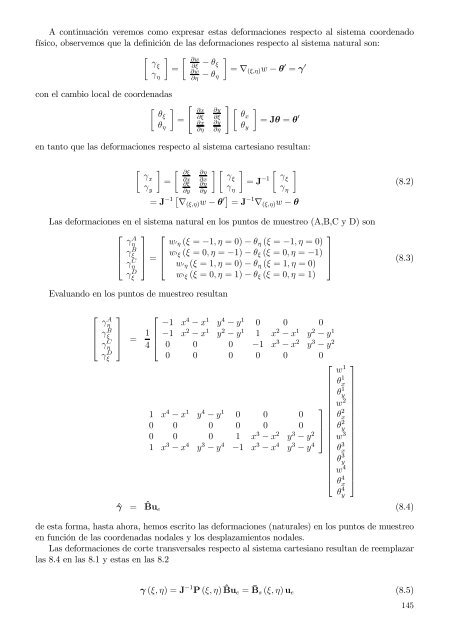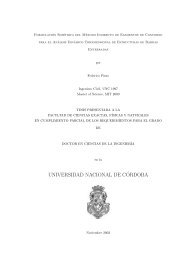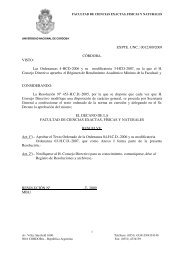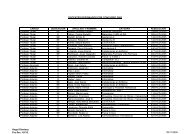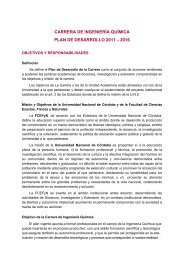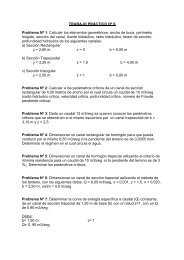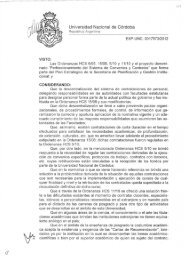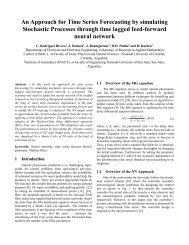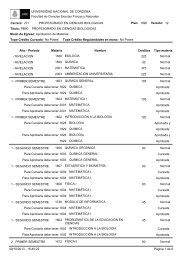Capítulo 1 Métodos de residuos ponderados Funciones de prueba ...
Capítulo 1 Métodos de residuos ponderados Funciones de prueba ...
Capítulo 1 Métodos de residuos ponderados Funciones de prueba ...
Create successful ePaper yourself
Turn your PDF publications into a flip-book with our unique Google optimized e-Paper software.
A continuación veremos como expresar estas <strong>de</strong>formaciones respecto al sistema coor<strong>de</strong>nado<br />
físico, observemos que la <strong>de</strong>finición <strong>de</strong> las <strong>de</strong>formaciones respecto al sistema natural son:<br />
[ ] [ ∂w<br />
γξ<br />
=<br />
− θ ]<br />
∂ξ ξ<br />
∂w<br />
γ η ∂η − θ = ∇ (ξ,η) w − θ ′ = γ ′<br />
η<br />
con el cambio local <strong>de</strong> coor<strong>de</strong>nadas<br />
[ ]<br />
θξ<br />
=<br />
θ η<br />
[<br />
∂x<br />
∂ξ<br />
∂x<br />
∂η<br />
∂y<br />
∂ξ<br />
∂y<br />
∂η<br />
] [ ]<br />
θx<br />
= Jθ = θ ′<br />
θ y<br />
en tanto que las <strong>de</strong>formaciones respecto al sistema cartesiano resultan:<br />
[<br />
γx<br />
]<br />
=<br />
γ y<br />
[ ∂ξ<br />
∂x<br />
∂ξ<br />
∂y<br />
∂η<br />
∂x<br />
∂η<br />
∂y<br />
] [<br />
γξ<br />
γ η<br />
]<br />
= J −1 [<br />
γξ<br />
γ η<br />
]<br />
= J −1 [ ∇ (ξ,η) w − θ ′] = J −1 ∇ (ξ,η) w − θ<br />
(8.2)<br />
Las <strong>de</strong>formaciones en el sistema natural en los puntos <strong>de</strong> muestreo (A,B,C y D) son<br />
⎡ ⎤ ⎡<br />
⎤<br />
γ A η<br />
w′ ⎢ γ B η (ξ = −1, η = 0) − θ η (ξ = −1, η = 0)<br />
ξ ⎥<br />
⎣ γ C ⎦ = ⎢<br />
w′ ξ (ξ = 0, η = −1) − θ ξ (ξ = 0, η = −1)<br />
⎥<br />
⎣<br />
η<br />
w′ η (ξ = 1, η = 0) − θ η (ξ = 1, η = 0) ⎦ (8.3)<br />
γ D ξ<br />
w′ ξ (ξ = 0, η = 1) − θ ξ (ξ = 0, η = 1)<br />
Evaluando en los puntos <strong>de</strong> muestreo resultan<br />
⎡<br />
⎢<br />
⎣<br />
γ A η<br />
γ B ξ<br />
γ C η<br />
γ D ξ<br />
⎤<br />
⎥<br />
⎦ = 1 4<br />
⎡<br />
⎢<br />
⎣<br />
−1 x 4 − x 1 y 4 − y 1 0 0 0<br />
−1 x 2 − x 1 y 2 − y 1 1 x 2 − x 1 y 2 − y 1<br />
0 0 0 −1 x 3 − x 2 y 3 − y 2<br />
0 0 0 0 0 0<br />
⎤<br />
1 x 4 − x 1 y 4 − y 1 0 0 0<br />
0 0 0 0 0 0<br />
⎥<br />
0 0 0 1 x 3 − x 2 y 3 − y 2 ⎦<br />
1 x 3 − x 4 y 3 − y 4 −1 x 3 − x 4 y 3 − y 4 ⎢<br />
⎣<br />
ˆγ = ˆBu e (8.4)<br />
⎡<br />
w 1<br />
θ 1 x<br />
θ 1 y<br />
w 2<br />
θ 2 x<br />
θ 2 y<br />
w 3<br />
θ 3 x<br />
θ 3 y<br />
w 4<br />
θ 4 x<br />
θ 4 y<br />
⎤<br />
⎥<br />
⎦<br />
<strong>de</strong> esta forma, hasta ahora, hemos escrito las <strong>de</strong>formaciones (naturales) en los puntos <strong>de</strong> muestreo<br />
en función <strong>de</strong> las coor<strong>de</strong>nadas nodales y los <strong>de</strong>splazamientos nodales.<br />
Las <strong>de</strong>formaciones <strong>de</strong> corte transversales respecto al sistema cartesiano resultan <strong>de</strong> reemplazar<br />
las 8.4 en las 8.1 y estas en las 8.2<br />
γ (ξ, η) = J −1 P (ξ, η) ˆBu e = ¯B s (ξ, η) u e (8.5)<br />
145


